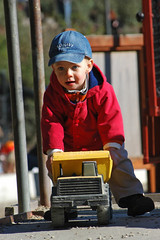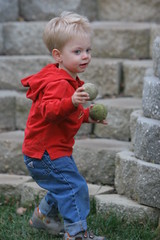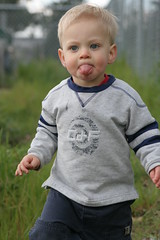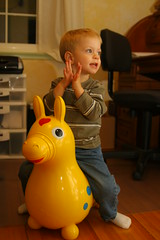How to Take Child Candid Portraits
If you want to improve your child candid portraits, you're going to have to get your knees dirty.
I mention this because the cleaner your environment, the less likely you're going to have a child who is relaxed and entertained.
Whether outdoors or inside, your best chance at capturing an engaging child candid portrait will definitely involve crawling around a bit.
Tip #1 - Get Down at Their Level
The first step that you can take that will immediately improve your child candid portraits is to get down at their level.
When you take photos of children looking down on them from above, two things happen:
- Their heads look much larger than the rest of their bodies (due to perspective)
- They look much smaller than they really are
When I take photos of my two year-old son (or any small child for that matter) I am always kneeling and sometimes I'm even lying down.
Your goal is to keep the camera level with their eyes.
This ensures that their bodies appear correctly proportioned and improves your chances of getting a photo where they're looking right at you (since it's a lot harder for them to look at you if you're WAY above them).
Tip #2 - Use Standard Lenses
A good portrait lens is neither wide-angle nor telephoto, but somewhere right in the middle.
Wide angle lenses (11 to 28mm) distort facial features, and make noses appear much more prominent than they really are.
Telephoto lenses (200mm or more) tend to flatten everything, resulting in a portrait that is less three-dimensional.
This means that the type of lens you want to use for child portraits is right in the middle of this range: anywhere between 50mm and 100mm is ideal.
These so-called "standard" lenses will yield the most natural-looking results and will capture the children as your eyes see them.
Tip #3 - Seek the Shade
If you really want your child candid portraits to shine, DO NOT take them in direct sunlight.
While direct sunlight might seem like an ideal, it really isn't when it comes to taking photos with a digital SLR camera.
Direct sunlight results in too much contrast for your camera to capture accurately.
The end result is VERY dark shadows, which obscure parts of the child's face, especially if he enjoys wearing baseball hats (as mine does).
There are two types of light that are significantly better for child portraits: shade and overcast.
Muted light is much more even and balanced, and the reduced range of contrast makes it easier for your camera to capture details from shadow to highlight.
Tip #4 - Use a Fast Shutter Speed
Unless you want all of your child candid portraits to turn out blurry, you're going to have to use a fast shutter speed.
Unlike landscapes and still life setups, children rarely sit still.
While you can get them to sit still for a posed "formal" portrait, many children wind up looking VERY stiff in these circumstances.
They know that you're taking a picture of them and either don't smile very much or produce one of those forced "I'm smiling because you told me to" looks.
Since what we're talking about here is candid portraits, you won't be asking the kids to pose and you won't ask them to stop doing whatever is keeping them occupied.
Once a child is in motion, only shutter speeds faster than 1/125th of a second are going to produce clear photos.
If you can't get a shutter speed this fast (due to dim lighting) then you have to wait for the action to peak.
For example, if you're taking photos of a child in a swing, take your shots right at the peak of the swing (when the motion stops ![]() ) rather than in the middle of the swing (when the kid's going full speed).
) rather than in the middle of the swing (when the kid's going full speed).
Tip #5 - Take 100 Photos Too Many
The time that I've spent taking child candid portraits has taught me one thing for certain: facial expression is the KEY.
You can compare two virtually identical child portraits side-by-side where everything is the same save the child's expression. One will be a keeper, and the other will be a dud.
The mere tilt of a head, smile, or position of the arms and body is what's going to make or break your child candid portrait.
How do you get more keepers than duds? Take WAY too many photos.
Once you have a kid who's entertained and you find one of those special moments when the light's just right, keep snapping away.
Set your camera to burst mode and take three photos in rapid succession when you might otherwise only take one.
Yes, you'll have to do a lot of editing after the fact, but it's well worth it when you find that you've captured a priceless expression that is there in one frame and gone in the next.
Tip #6 - NEVER Take a Breather
This tip is related to the previous one: once you get into the groove, don't drop the viewfinder from your eye and don't remove your finger from the shutter release button.
The reason is simple: since you're not deliberatly posing your subjects, you never know when they're going to strike a pose.
There's another reason this tip is important: once a child strikes a pose that you really love, chances are that they won't be able to do it again, no matter how much you coax them (and then it's not a candid portrait anymore, right?).
The best thing to do then is to be prepared: the moment the child settles into a position that you really like, grab 10 photos.
When you constantly have the camera up to your eye and your finger poised on the shutter release, there's no chance that you'll miss one of these fleeting moments.
Tip #7 - Use Props
There is one certainty when it comes to child candid portraits: your subjects have limited attention spans.
This explains why most people have a tough time with their kids in a sterile portrait studio - there's nothing to do!
But you're not working in a studio, so the best thing to have at hand is a lot of props that will keep their attention for an extended period of time.
Whether it's puzzles to put together, balls to bounce on or crayons to draw with, kids will sit still longer when they're occupied.
There's a side benefit to this approach: when the kid's attention is engaged in something else they completely forget that you're there taking pictures.
End result: more relaxed and natural-looking portraits.
Since they're not being forced to pose, kids can do exactly what they want. They don't mug for the camera and they don't go stiff as boards.
If you're poised to capture a brief moment in time (see tips 5 and 6 above), the results of your child candid portrait session will be pictures that you'll cherish for years to come.

|










